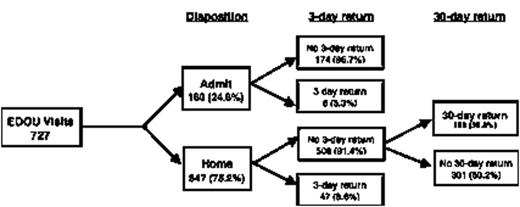Abstract
Background: Emergency Department Observation Units (EDOUs) and Sickle Cell Pathways (SCPs) allow for protocol based rapid initiation of analgesic treatment for sickle cell disease (SCD) patients during a vaso-occlusive crisis (VOC). Initially, Emergency Department (ED) physicians managed patients on the SCP in the EDOU. After an administration change in September 2013, the Hospitalists service provided protocol based care in the EDOU for the SCP after the initial ED assessment. The Hospitalists service management model incorporates mid-level providers (Nurse Practitioners and Physicians Assistants) into the management of patients on the SCP. The SCP utilizes an individual dosage database using patient-controlled analgesia delivered narcotics. No other changes were made to the pathway during the study period other than the type of physician management.
Objective: To compare admission rates between ED physicians and Hospitalists service management of patients on a SCP. Our secondary objective was to ascertain if there was a difference in the three and 30-day return rates of SCD patients managed by ED physicians as compared to hospitalists.
Methods: This study was a retrospective database review using a database created from visits of patients with VOC to the EDOU. Data were analyzed for a 21-month period (December, 2011 - August, 2013) in which patient care was managed by ED physicians and the 21-month period (September, 2013 -May, 2015) in which it was managed by the Hospitalists service. 773 patient encounters were included from the ED physicians management period and 727 from the Hospitalists management period. The database was reviewed for information on length of stay (LOS), disposition, three and 30-day return, and readmission rates. Only uncomplicated pain crisis visits due to SCD presenting to the ED were included in this study.
Results: The average EDOU length of stay (LOS) for a SCD patient during the ED management period was 17 hours and 54 minutes; during the Hospitalists management period, the average LOS was 18 hours and 23 minutes. The data were analyzed by patient disposition, three and 30-day return rate as shown in Figure 1 and Figure 2 below.
Figures 1 and 2 show that the admittance rate for SCP patients during the ED management period was 16% while during the Hospitalist management period the admission rate was 24.8%. Statistical analysis shows that this difference is significant (p<0.0001). The 30-day return rates for patients who did not return at three days were not significantly different. Of the patients initially admitted to the hospital, the 30-day readmission rate following EDOU return under the ED management period (not included in the figure) was 8.9% while it was 15.6% for the Hospitalist management period (p<0.001).
Discussion: Analysis of the data shows that the EDOU LOS was not statistically different between groups (p=.1853), suggesting that the disposition decision time and treatment time was similar for both types of physician management. Patients were admitted at a statistically significant higher rate under Hospitalist management than ED management. However, there is no statistically significant difference in the three day return rates between the two groups, indicating that this increased admittance did not lead to a decrease in return rates. The three-day return rate is a marker of the efficacy and appropriate disposition from the pathway. Similarly the 30-day return rates of the two groups were nearly identical (41.1% versus 39.8%). However, while the patients returned to the EDOU at the same rate, they were statistically more likely to be readmitted upon their return by hospitalists as compared to ED physicians (p<0.001).
This study demonstrates Hospitalists service management, staffed with midlevel providers, produces different outcomes than ED management. Although the study does not explain this difference it raises important questions for further study regarding adherence to treatment protocol, confidence in disposition decisions, and inter-professional communications. Despite the differences in the outcomes between the two management groups, the outcomes of the Hospitalists group are better than national averages. Thus, this is a viable model for the pathway management of patients with SC VOC.
ED physician management of the EDOU (December, 2011 - August, 2013)
No relevant conflicts of interest to declare.
Author notes
Asterisk with author names denotes non-ASH members.



This feature is available to Subscribers Only
Sign In or Create an Account Close Modal